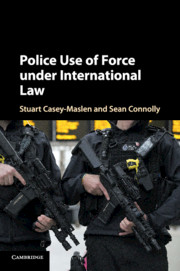28 results
Interactive impact of childhood maltreatment, depression, and age on cortical brain structure: mega-analytic findings from a large multi-site cohort
-
- Journal:
- Psychological Medicine / Volume 50 / Issue 6 / April 2020
- Published online by Cambridge University Press:
- 14 May 2019, pp. 1020-1031
-
- Article
-
- You have access
- Open access
- HTML
- Export citation
6 - Facilitating Peaceful Protest and Ensuring Crowd Safety during Assemblies
-
- Book:
- Police Use of Force under International Law
- Published online:
- 30 August 2017
- Print publication:
- 10 August 2017, pp 184-222
-
- Chapter
- Export citation
4 - Use of Firearms
-
- Book:
- Police Use of Force under International Law
- Published online:
- 30 August 2017
- Print publication:
- 10 August 2017, pp 108-145
-
- Chapter
- Export citation
11 - Accountability
-
- Book:
- Police Use of Force under International Law
- Published online:
- 30 August 2017
- Print publication:
- 10 August 2017, pp 374-402
-
- Chapter
- Export citation
8 - Use of Force in Counterterrorism
-
- Book:
- Police Use of Force under International Law
- Published online:
- 30 August 2017
- Print publication:
- 10 August 2017, pp 261-299
-
- Chapter
- Export citation
3 - Core Principles Governing Use of Force for Law Enforcement
-
- Book:
- Police Use of Force under International Law
- Published online:
- 30 August 2017
- Print publication:
- 10 August 2017, pp 79-107
-
- Chapter
- Export citation
Abbreviations and Acronyms
-
- Book:
- Police Use of Force under International Law
- Published online:
- 30 August 2017
- Print publication:
- 10 August 2017, pp ix-xii
-
- Chapter
- Export citation
7 - Use of Force in Custodial Settings
-
- Book:
- Police Use of Force under International Law
- Published online:
- 30 August 2017
- Print publication:
- 10 August 2017, pp 223-260
-
- Chapter
- Export citation
1 - A History of Law Enforcement
-
- Book:
- Police Use of Force under International Law
- Published online:
- 30 August 2017
- Print publication:
- 10 August 2017, pp 10-50
-
- Chapter
- Export citation
Index
-
- Book:
- Police Use of Force under International Law
- Published online:
- 30 August 2017
- Print publication:
- 10 August 2017, pp 403-423
-
- Chapter
- Export citation
10 - Counterpiracy at Sea
-
- Book:
- Police Use of Force under International Law
- Published online:
- 30 August 2017
- Print publication:
- 10 August 2017, pp 341-373
-
- Chapter
- Export citation
Copyright page
-
- Book:
- Police Use of Force under International Law
- Published online:
- 30 August 2017
- Print publication:
- 10 August 2017, pp iv-iv
-
- Chapter
- Export citation
9 - Private Security and Use of Force
-
- Book:
- Police Use of Force under International Law
- Published online:
- 30 August 2017
- Print publication:
- 10 August 2017, pp 300-340
-
- Chapter
- Export citation
Introduction
-
- Book:
- Police Use of Force under International Law
- Published online:
- 30 August 2017
- Print publication:
- 10 August 2017, pp 1-9
-
- Chapter
- Export citation
Acknowledgements
-
- Book:
- Police Use of Force under International Law
- Published online:
- 30 August 2017
- Print publication:
- 10 August 2017, pp viii-viii
-
- Chapter
- Export citation
5 - Use of ‘Less-Lethal’ Weapons
-
- Book:
- Police Use of Force under International Law
- Published online:
- 30 August 2017
- Print publication:
- 10 August 2017, pp 146-183
-
- Chapter
- Export citation
Contents
-
- Book:
- Police Use of Force under International Law
- Published online:
- 30 August 2017
- Print publication:
- 10 August 2017, pp v-vii
-
- Chapter
- Export citation

Police Use of Force under International Law
-
- Published online:
- 30 August 2017
- Print publication:
- 10 August 2017
2 - Policing and Social and Economic Policy
-
- Book:
- Police Use of Force under International Law
- Published online:
- 30 August 2017
- Print publication:
- 10 August 2017, pp 51-78
-
- Chapter
- Export citation
Substrate affinities of higher taxa and the Ordovician Radiation
-
- Journal:
- Paleobiology / Volume 27 / Issue 4 / Fall 2001
- Published online by Cambridge University Press:
- 20 May 2016, pp. 768-778
-
- Article
- Export citation



